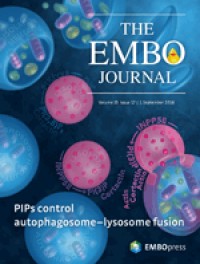EMBO Journal Q1 Unclaimed
Launched in 1982, The EMBO Journal publishes high quality research of broad interest and impact across molecular and cell biology with an emphasis on physiological relevance and molecular mechanism. The Journal is one of four journals owned and run by the European Molecular Biology Organization (EMBO) and published through EMBO Press with support from Wiley and HighWire Press. The journal welcomes submission of all articles, in particular on the following biological processes, investigated at a It has an SJR impact factor of 4,821.
EMBO Journal focuses its scope in these topics and keywords: protein, gene, response, cell, dna, human, induction, receptor, rna, transcription, ...
Type: Journal
Type of Copyright:
Languages: English
Open Access Policy: Open Choice
Type of publications:
Publication frecuency: -


4711 €
Inmediate OANPD
Embargoed OA2340 €
Non OAMetrics
4,821
SJR Impact factor441
H Index296
Total Docs (Last Year)913
Total Docs (3 years)20462
Total Refs7991
Total Cites (3 years)841
Citable Docs (3 years)7.14
Cites/Doc (2 years)69.13
Ref/DocOther journals with similar parameters
Molecular Cell Q1
Cell Research Q1
Annual Review of Plant Biology Q1
Cell Host and Microbe Q1
Annual Review of Medicine Q1
Compare this journals
Aims and Scope
Best articles by citations
ACBD3-mediated recruitment of PI4KB to picornavirus RNA replication sites
View moreStructural basis of the interaction between the AAA ATPase p97/VCP and its adaptor protein p47
View moreExpression of the noncatalytic domain of the NIMA kinase causes a G2 arrest in Aspergillus nidulans.
View moreActivation of the prespore and spore cell pathway of Dictyostelium differentiation by cAMP-dependent protein kinase and evidence for its upstream regulation by ammonia.
View moreA 70-kd protein of the yeast mitochondrial outer membrane is targeted and anchored via its extreme amino terminus.
View moreMetal ion regulated gene expression: use of a plastocyanin-less mutant of Chlamydomonas reinhardtii to study the Cu(II)-dependent expression of cytochrome c-552.
View moreThe yeast spt14 gene is homologous to the human PIG-A gene and is required for GPI anchor synthesis.
View moreInteractions with fibronectin attenuate the virulence of Streptococcus pyogenes
View moreIdentification and characterization of novel nicotinic receptor-associated proteins in Caenorhabditis elegans
View moreThe cloning and characterization of the bacteriophage D108 regulatory DNA-binding protein ner.
View morePositive and negative cis-acting DNA domains are required for spatial and temporal regulation of gene expression by a seed storage protein promoter.
View moreAt least 60 ADP-ribosylated variant histones are present in nuclei from dimethylsulfate-treated and untreated cells.
View moreTransferrin receptor-like proteins control the degradation of a yeast metal transporter
View moreOff-track takes Frizzled off the canonical path
View moreMechanism controlling perpendicular alignment of the spindle to the axis of cell division in fission yeast
View moreDeletion of complement C4 and steroid 21-hydroxylase genes in the HLA class III region.
View moreIn vivo inhibition of duck hepatitis B virus replication and gene expression by phosphorothioate modified antisense oligodeoxynucleotides.
View morePIAS adds methyl-bias to HSC-differentiation
View moreKes1p shares homology with human oxysterol binding protein and participates in a novel regulatory pathway for yeast Golgi-derived transport vesicle biogenesis.
View moreIdentification of
View moreDevelopmentally and spatially regulated activation of a Dictyostelium STAT protein by a serpentine receptor
View morePhospholipid transfer activity is relevant to but not sufficient for the essential function of the yeast SEC14 gene product.
View moreRSC regulates nucleosome positioning at Pol II genes and density at Pol III genes
View moreA novel protein kinase gene ssp1+ is required for alteration of growth polarity and actin localization in fission yeast.
View more
Comments